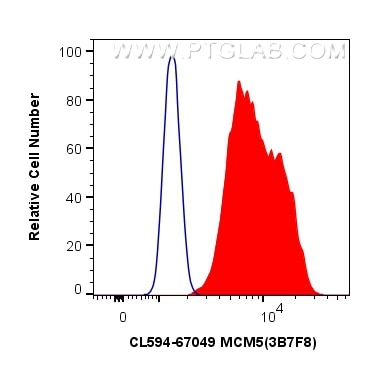MCM5 Monoklonaler Antikörper
MCM5 Monoklonal Antikörper für FC (Intra)
Wirt / Isotyp
Maus / IgG1
Getestete Reaktivität
human
Anwendung
FC (Intra)
Konjugation
CoraLite®594 Fluorescent Dye
CloneNo.
3B7F8
Kat-Nr. : CL594-67049
Synonyme
Geprüfte Anwendungen
| Erfolgreiche Detektion in FC (Intra) | MCF-7-Zellen |
| Erfolgreiche Detektion in FC | MCF-7-Zellen |
Empfohlene Verdünnung
| Anwendung | Verdünnung |
|---|---|
| Durchflusszytometrie (FC) (INTRA) | FC (INTRA) : 0.40 ug per 10^6 cells in a 100 µl suspension |
| Durchflusszytometrie (FC) | FC : 0.40 ug per 10^6 cells in a 100 µl suspension |
| It is recommended that this reagent should be titrated in each testing system to obtain optimal results. | |
| Sample-dependent, check data in validation data gallery | |
Produktinformation
CL594-67049 bindet in FC (Intra) MCM5 und zeigt Reaktivität mit human
| Getestete Reaktivität | human |
| Wirt / Isotyp | Maus / IgG1 |
| Klonalität | Monoklonal |
| Typ | Antikörper |
| Immunogen | MCM5 fusion protein Ag28704 |
| Vollständiger Name | minichromosome maintenance complex component 5 |
| Berechnetes Molekulargewicht | 82 kDa |
| Beobachtetes Molekulargewicht | 82-88 kDa |
| GenBank-Zugangsnummer | BC000142 |
| Gene symbol | MCM5 |
| Gene ID (NCBI) | 4174 |
| Konjugation | CoraLite®594 Fluorescent Dye |
| Excitation/Emission maxima wavelengths | 588 nm / 604 nm |
| Form | Liquid |
| Reinigungsmethode | Protein-G-Reinigung |
| Lagerungspuffer | PBS with 50% glycerol, 0.05% Proclin300, 0.5% BSA |
| Lagerungsbedingungen | Bei -20°C lagern. Vor Licht schützen. Nach dem Versand ein Jahr stabil. Aliquotieren ist bei -20oC Lagerung nicht notwendig. 20ul Größen enthalten 0,1% BSA. |
Hintergrundinformationen
Minichromosome maintenance, S. Cerevisiae, homolog of 5(MCM5), one component of the complex of MCM2-7, which is the putative replicative essential for once per cell cycle DNA replication initiation and elongation in eukaryotic cells. The MCM complex form a hexameric ring through the interaction surfaces of two neighboring subunits.
Protokolle
| PRODUKTSPEZIFISCHE PROTOKOLLE | |
|---|---|
| FC protocol for CL594 MCM5 antibody CL594-67049 | Download protocol |
| STANDARD-PROTOKOLLE | |
|---|---|
| Klicken Sie hier, um unsere Standardprotokolle anzuzeigen |


